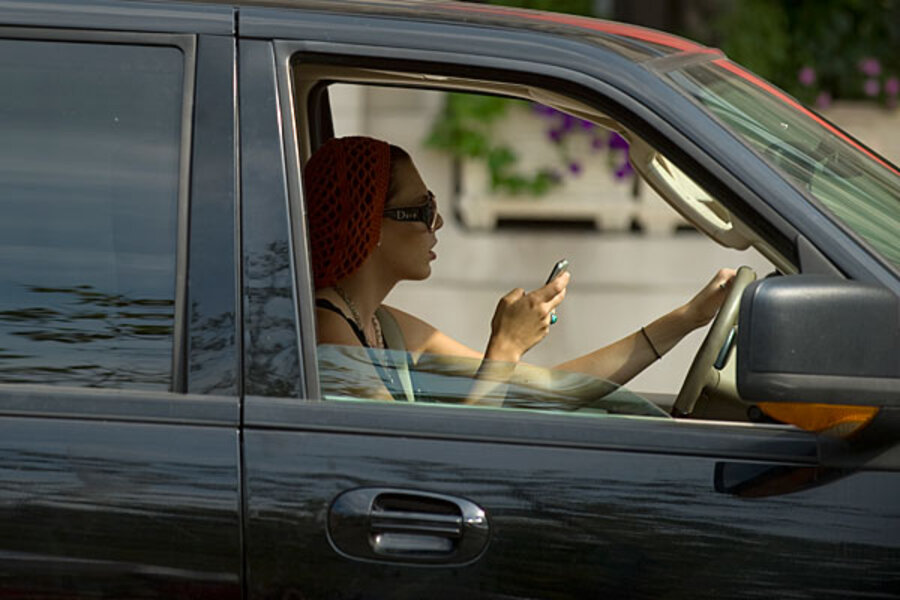A two-second rule for distracted drivers? Automakers asked to restrict tech.
Loading...
| Washington
Transportation officials want you to take your eyes off the road for no more than two seconds at a time, and they are asking automakers to help.
New voluntary guidelines released Tuesday by the US Department of Transportation and the National Highway Transportation Safety Administration (NHTSA) seek to curb distracted driving by limiting drivers’ use of in-vehicle electronics while the vehicles are in motion. The guidelines ask automakers to place restrictions on in-car technologies, especially those connected to the Internet.
Proponents say the voluntary guidelines, which are to be phased in over the next three years, will help curb distracted driving. But critics argue that the guidelines unfairly target automakers.
What’s not in dispute is the growing impact of technology on driving. Federal data report that, in 2011, crashes involving a distracted driver killed 3,331 people and injured another 387,000. For teenagers, the problem is worse: Car accidents are the No. 1 cause of death of teens (indeed, of all people ages 5 to 34), and a quarter of all teen-driving crashes are attributed to distracted driving. And, despite an increase in bans on cellphone use while driving, an NHTSA survey released earlier this month shows that this usage has remained steady during the past two years.
The new guidelines target only the electronic systems found in many newer cars. These systems mirror the capabilities of an Internet-enabled PC or tablet and often have large in-dash touch screens that coordinate navigation, phone calls, music, and text messaging. Many allow Web browsing and social media activity, complete with text and multimedia displays. Some cars also allow drivers to sync their smart phone to the in-vehicle system.
The NHTSA says the guidelines include some changes to address automakers' concerns and to reflect the input of industry groups, researchers, and advocates. "These guidelines recognize that today's drivers appreciate technology," said Transportation Secretary Ray LaHood in a press release, "while providing automakers with a way to balance the innovation consumers want with the safety we all need."
Specifically the guidelines ask automakers to develop technology that would limit the time a driver must take his or her eyes off the road to complete a specific task, such as adjusting or selecting music, to two seconds. And it would put a 12-second limit on more detailed tasks, such as initiating a phone call. A series of two-second actions could thus not exceed a 12-second cumulative time period for the task as a whole – unless the vehicle is stopped and in park.
This limitation would allow drivers to choose preset locations on maps or navigation devices, but would generally not allow enough time to input a new address while driving. The guidelines also ask automakers to develop technology that disallows any amount of manual text entry for communication or Internet browsing. The limitations would restrict all social media and Web-browsing activities unless the car is parked. And the system would not display text, images, or video while the car is in motion either. This restriction would not apply to maps and dynamic navigation systems.
NHTSA says the regulations are in line with the findings of their new study, also released Tuesday, which shows that the likelihood of a crash or near-crash increases threefold when drivers are looking at screens or touching their devices.
Because the new voluntary guidelines from NHTSA focus only on in-vehicle technologies, some of the big automakers have argued they will fail to truly limit distracted driving. They have pointed out that more crashes have been linked to the use of hand-held phones than to in-vehicle systems.
Research also shows that distracted driving results from a variety of behaviors, including speaking on the phone, eating and drinking, talking to passengers, grooming, reading, using a navigation system, and adjusting the radio.
The Alliance of Automobile Manufacturers, the trade group that represents Detroit's Big Three, Toyota, and other automakers, has urged the NHTSA to look at how guidelines might apply to cellphone-makers and application developers as well.
The alliance isn’t unconcerned with distracted driving; it has had its own set of guidelines in place for a several years. And many automakers already place restrictions on use of in-vehicle systems while the car is in motion. But Mitch Bainwol, president and chief executive officer of the alliance, has said these new voluntary restrictions will simply push drivers to use their hand-held devices (not synced to the car system). This poses an even greater safety risk as he says it encourages drivers to “look down, not up.”
Automakers have noted other ways drivers will get around the restrictions – including the use of aftermarket devices that unlock these limitations. They have also argued that the 12-second time limit on task completion is unrealistic and should be expanded to 20 seconds.
Disagreement over specifics aside, the question of whether technology can ever be made “safe” in vehicles remains. A study released Tuesday from the Texas A&M Transportation Institute found no safety benefits in the use of voice-to-text applications (such as the iPhone's Siri) over manual texting. In fact, the study found that “driver response times were significantly delayed no matter which texting method was used.”
Christine Yager, who directed the study, says “more and more technology” in cars – even if it is made safer – is “not necessarily the answer.” She says this is “because there are three ways that drivers can be distracted – hands, eyes, or mind” and that “anything that takes anything away from primary task of driving” poses a safety risk.
“Technical solutions, legislation, education, and public research all [play] a role,” she says, in advancing solutions to combat distracted driving. And this work is “constantly evolving because of all technologies constantly hitting the market.”







